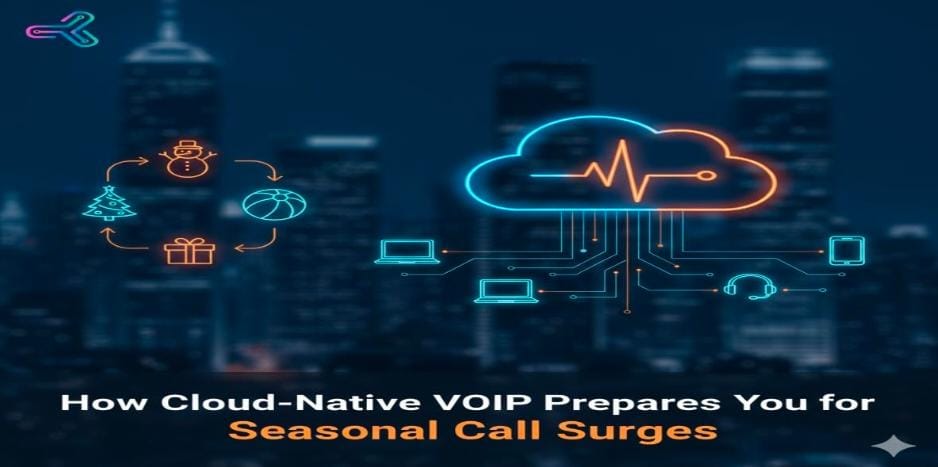Let’s talk about how your business handles peak-season calls. Are you relying on legacy systems that struggle under pressure, or have you explored cloud-native VoIP solutions that scale automatically and keep your customers happy?
During holidays, product launches, or big promotional campaigns, call volumes can spike dramatically, putting immense pressure on customer support teams.
❌ Long wait times,
❌ frustrated customers, and
❌ stressed agents
are all too common when a business isn’t prepared!
This is where having a flexible and custom scalable VoIP solution becomes critical, not just to manage the surge, but to ensure a smooth, positive experience for your customers.
However, not all communication systems are built to handle these high-demand moments, especially legacy setups.
| What Are Seasonal Call Surges and Why Do They Happen? Seasonal call surges are sudden spikes in customer calls during holidays, campaigns, or product launches. They often lead to: Overloaded agents & long waits – 68% of customers hang up if kept waiting too long. Poor experiences – 60% stop buying after one bad interaction. Missed revenue – Each unanswered call can mean a lost sale. A scalable VoIP infrastructure helps handle these surges smoothly, keeping service consistent and customers happy. |
However, not all communication systems are built to handle these high-demand moments, especially legacy setups.
Let’s see where they fall short!
Why do traditional phone systems fail during seasonal call surges?
Traditional phone systems often struggle when call volumes rise suddenly because they’re built on rigid, hardware-dependent setups. While they work fine for steady, predictable call traffic, they lack the agility and scalability needed during peak seasons like holidays or product launches.
Here’s why they fall short when it matters most:
Limited scalability: Traditional phone lines can’t be expanded instantly. Adding new lines or capacity often requires extra hardware and setup time, making it impossible to react quickly to sudden surges.
High operational costs: Maintaining physical infrastructure just to handle occasional spikes isn’t cost-effective. Businesses end up paying for capacity they rarely use.
No intelligent routing: Legacy systems don’t support smart call distribution, which means incoming calls can overload certain agents while others sit idle, hurting overall efficiency.
Increased downtime risk: Hardware failures or system overloads during busy periods can interrupt service right when customer demand is highest.
Poor customer experience: Long wait times, dropped calls, and slow response rates lead to frustrated customers, and that frustration can quickly translate into lost sales or negative reviews.
So, this is where traditional systems reach their limit, and the need for a more flexible, cloud-native VoIP solution begins to surge.
And here’s how cloud-native VoIP turns those challenges into opportunities.
What are the Advantages of a Cloud-native VoIP System?
A cloud-native VoIP system for businesses gives the flexibility and control they need to manage communication during seasonal spikes. Unlike traditional setups, it’s built on a scalable VoIP infrastructure that adapts automatically as call volumes change. Whether you’re handling everyday traffic or a sudden holiday rush, it keeps your customer experience smooth and consistent.
Here are some key advantages in detail:
Scaling? A scalable VoIP solution lets you increase or reduce your call capacity and agent lines instantly. During holidays, promotions, or product launches, your system adapts automatically. No hardware upgrades, no last-minute scrambling, just smooth operations even when call volumes double or triple.
Reliability? A scalable VoIP infrastructure is built to stay online under heavy loads. Multiple server backups and cloud hosting ensure your communication never goes down, meaning no missed calls, no frustrated customers, and no stress for your team.
Routing? Intelligent call routing makes sure each customer reaches the right agent fast, whether it’s based on availability, expertise, or priority. This reduces wait times, improves first-call resolution, and keeps your support efficient, even during surges.
Cost? You only pay for what you use. No need to invest in extra lines, hardware, or idle capacity that’s only needed occasionally. Cloud-native VoIP systems are flexible, making them a much smarter and budget-friendly option compared to traditional setups.
Insights? Real-time dashboards and analytics show call volumes, peak hours, and agent performance. You can forecast demand, allocate resources smartly, and prevent bottlenecks before they happen. It’s like having a pulse on your entire support operation.
Integration? Cloud-native VoIP connects easily with CRM systems, helpdesk platforms, and AI tools. Agents can see customer details instantly, handle calls faster, and provide personalized service, all from a single interface.
Experience? Ultimately, your customers benefit the most. Faster responses, smoother handling, and shorter wait times improve satisfaction and loyalty. A cloud-native VoIP system doesn’t just manage calls, it enhances the overall customer experience.
Understanding the advantages of a cloud-native VoIP system is one thing, but seeing how it directly improves customer experience during call surges shows its real impact.
How Cloud-Native VoIP Enhances Customer Experience During Surges?
A cloud-native VoIP system doesn’t just handle high call volumes; it actively improves the customer experience, even during peak times. Here’s how:
Faster call resolution and reduced hold times
During a holiday sale, your system routes calls to the next free agent, cutting hold times from 10 minutes to under a minute.
Cloud-native VoIP distributes incoming calls intelligently across available agents, ensuring no one waits too long.
Personalized interactions via integrated CRM
An agent can greet a returning customer by name and know their previous orders, speeding up query resolution and improving satisfaction.
By connecting to your CRM, the system gives agents instant access to customer history, preferences, and past interactions, making every call feel personal.
Omnichannel support to distribute load efficiently
During a product launch, some queries are handled via live chat while voice calls are routed to specialists, preventing queues from building up on any single channel.
Voice, chat, and email channels work together, letting customers reach you through their preferred medium and balancing the load across the team.
Now that you know how cloud-native VoIP can improve your customer experience, let’s talk about the best practices you can use to handle seasonal call surges smoothly.
4 Best Practices to Manage Seasonal Call Surges
So, what can you do to stay on top of seasonal call surges? The key is preparation. By planning ahead and using smart strategies, you can make sure your team stays efficient, customers aren’t left waiting, and no opportunity is missed. Handling peak periods doesn’t have to be stressful, it’s all about using the right approach and tools.
Here are some best practices to follow:
1. Forecast call volume using historical data
Analyze past trends during holidays, product launches, or special promotions to estimate how many calls you might receive. This helps in planning staffing levels, scheduling shifts, and ensuring your communication system can handle the expected load. Accurate forecasting reduces surprises and keeps both agents and customers from being overwhelmed.
2. Enable dynamic call routing and overflow strategies
Set up your system to automatically direct calls to available agents or alternate channels when lines are busy. Dynamic routing ensures that no customer is left waiting too long, and overflow strategies prevent bottlenecks by distributing calls efficiently across your team or even remote agents. This keeps your support running smoothly even during peak traffic.
3. Train agents for high-volume periods
Preparing your agents in advance is crucial. Provide clear instructions, scripts, and guidance on handling common questions quickly. Training helps agents remain calm and confident, manage calls efficiently, and reduce the risk of mistakes during stressful periods. Well-prepared agents deliver a better experience, even when the call volume spikes.
4. Use automation tools like IVRs and AI-driven assistants
Implement tools that can handle routine tasks and repetitive queries automatically. IVRs and AI assistants can manage tasks like checking order status, tracking shipments, or resetting passwords, freeing up agents to focus on more complex issues. This not only speeds up response times but also reduces customer frustration and keeps the support system running efficiently.
By following these best practices, businesses can stay organized, minimize customer wait times, and deliver a smooth, professional experience during even the busiest periods.
As we wrap up, with these opportunities and best practices in mind, it’s clear how a cloud-native VoIP system equips your business to handle seasonal call surges efficiently and effortlessly.
The Bottom Line?
Managing seasonal call spikes doesn’t have to be stressful or costly. A cloud-native VoIP system gives your business the flexibility, reliability, and intelligence to stay ahead, ensuring every customer call is handled efficiently.
| Key Takeaways- A cloud-native VoIP system provides scalable solutions that adjust automatically to sudden call surges without downtime or additional hardware. Intelligent routing, faster response times, and seamless integrations improve the customer experience and help maintain loyalty. Cloud-based infrastructure with pay-as-you-go pricing and real-time insights reduces costs while maximizing operational efficiency. |
Take the next step in upgrading your communication strategy with Ecosmob’s cloud-native VoIP solutions and make sure your business is ready for any seasonal surge.

